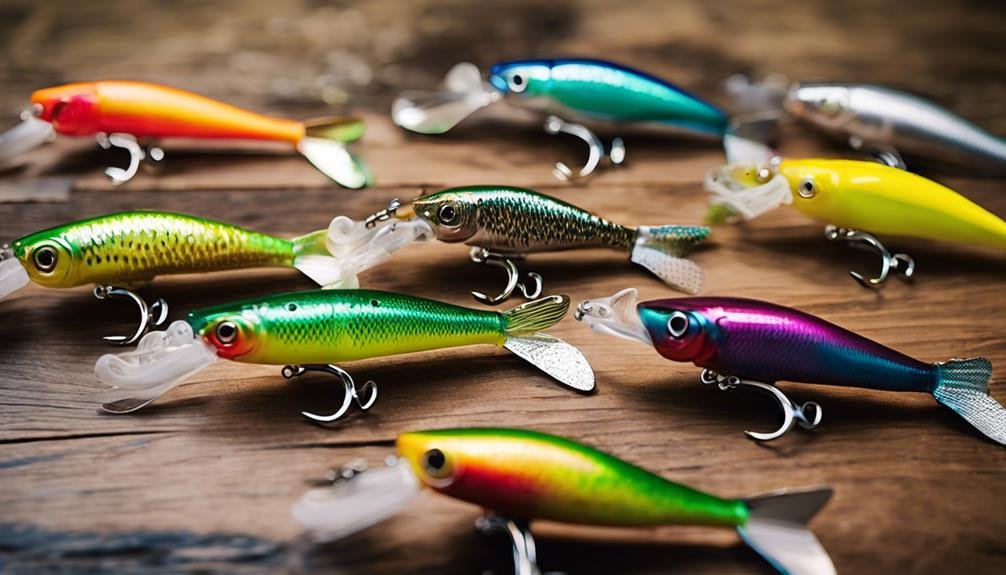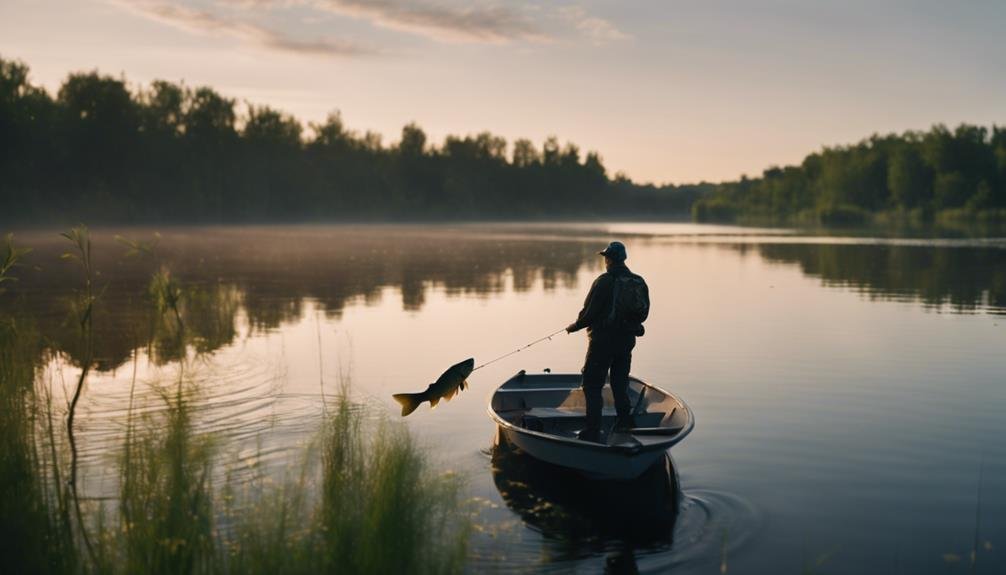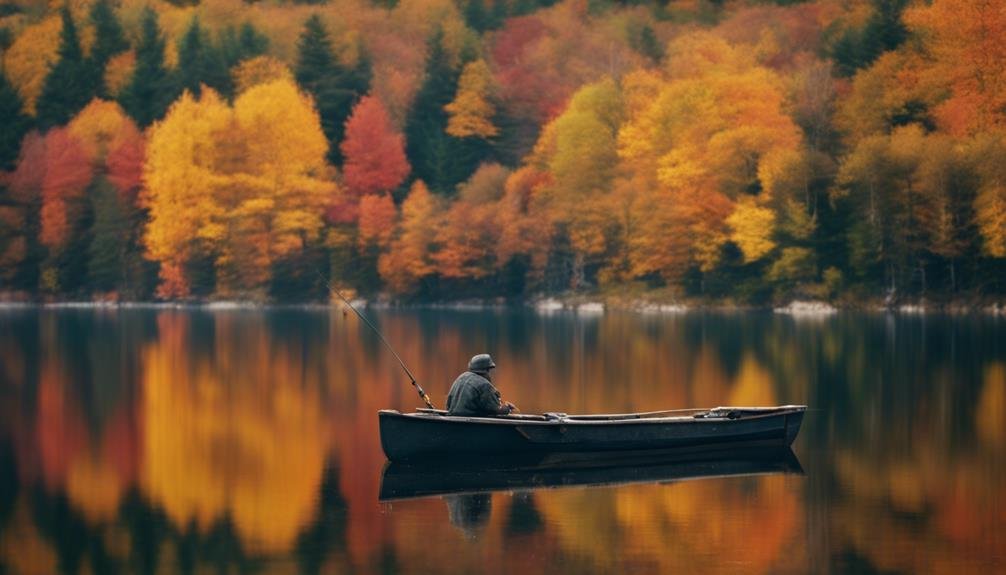When you set out to catch a musky, you’re not just fishing but engaging in a strategic battle of wits with one of freshwater’s most elusive predators. You’ll need more than just basic gear—specialized heavy-duty rods, braided lines, and an arsenal of lures like bucktails and glide baits are essential. But what’s the secret to choosing the right lure and technique? And how do you adapt to the musky’s unpredictable behavior? Understanding these nuances can transform your approach and make all the difference in your pursuit of the ultimate catch.
Key Takeaways
- Use heavy-duty rods and braided lines for durability and control.
- Choose lures based on water conditions: bucktails for clear water, jerk baits for weeds, and topwater baits for calm water.
- Experiment with retrieval techniques to trigger musky strikes, including varying speed and cadence.
- Prime fishing times include low light conditions and overcast skies for better musky activity.
- Patience and persistence are vital; muskies are elusive and selective feeders.
Why Muskies Are Hard to Catch

Catching muskies can feel like an uphill battle because they’re often elusive and highly selective feeders. You need to understand their feeding habits, which are influenced by water temperatures and the availability of forage species. Muskies aren’t like other fish; they don’t feed voraciously. Instead, they pick their moments, making timing incredibly important.
As water temperatures change, so do their feeding windows. When the water is cooler, muskies might feed less frequently, requiring you to be even more precise in your approach. They primarily target specific forage species, so knowing what’s available in their habitat can give you a significant advantage.
Larger muskies are even more selective, adding to the challenge. They often wait for the perfect opportunity to strike, so you must be persistent. Presenting the right lure at the right time is vital. If you miss their feeding window, you might as well be casting into the void.
Understanding these factors will help you better predict when and where muskies will likely feed. This knowledge, patience, and persistence are key to overcoming the challenges of catching these elusive fish.
Essential Gear for Musky Fishing
To improve your chances of landing a musky, having the right gear is as vital as understanding your feeding habits. Muskies are powerful fighters, and you’ll need robust equipment to handle them. Start with heavy-duty rods designed specifically for musky fishing. These rods provide the necessary strength and flexibility to manage these large fish.
Using a braided line is essential. It offers the strength and sensitivity to feel subtle bites and withstand the musky’s sharp teeth.
When it comes to lures, having a variety of soft plastics and glide baits in your tackle box can make a significant difference. These lures mimic the natural movement of the musky’s prey, increasing your chances of a successful catch.
Proper tools are also necessary for a smooth catch and release-process. Hook removers and needle-nose pliers help you safely and efficiently free the fish without causing unnecessary harm. Ensuring a quick release minimizes stress on the fish, promoting a sustainable fishing practice.
Here’s a list of essential gear for musky fishing:
- Heavy-duty rods
- Braided line
- Soft plastics
- Glide baits
- Hook removers
Investing in quality gear guarantees a successful and ethical fishing experience.
Choosing the Best Lures

When selecting lures for musky fishing, focus on bucktails, jerk baits, and topwater baits to attract these elusive fish effectively. Experimenting with different lure types is essential, as muskies can be finicky, and their preferences may vary depending on the water bodies and conditions you’re fishing. Soft plastics, glide baits, and topwater baits are popular choices that can yield great results.
Varying your retrieval speeds and depths can greatly impact your success. For instance, a slow, steady retrieval with a soft plastic can work wonders in calm water, while a more erratic, faster retrieval might be necessary in choppy conditions. Understanding musky behavior and adjusting your lure presentations is key to triggering strikes.
Here’s a quick comparison of some effective musky lures:
| Lure Type | Best Conditions | Retrieval Speed |
|---|---|---|
| Bucktails | Clearwater | Fast to medium |
| Jerkbaits | Weedy areas | Fast, with pauses |
| Topwater Baits | Calm water | Slow to medium |
| Soft Plastics | Deep or murky water | Slow to medium |
| Glide Baits | Open water | Medium, with twitches |
In-Line Spinners
Using in-line spinners like the Mepps Muskie Killer can greatly enhance your chances of landing a musky, especially when water temperatures rise above 50 degrees. These lures feature a spinning blade that creates a flash and vibration, mimicking the movement of prey and attracting the attention of muskies. The Mepps Muskie Killer is a versatile tool in your tackle box, allowing you to retrieve it at various speeds to trigger strikes from these elusive fish.
In-line spinners are particularly effective because they come in different sizes and colors, enabling you to match the forage in the water. Whether you’re casting in open water or near structures like weed beds and fallen trees, these lures perform well in diverse environments.
Here are some key features of in-line spinners:
- Spinning Blade: Generates flash and vibration to attract muskies.
- Versatile Retrieval: This can be retrieved at various speeds to provoke strikes.
- Size and Color Variety: Available in multiple sizes and colors to mimic local forage.
- Effective in Different Conditions: Suitable for both open water and near structures.
- Proven Success: Trusted by anglers for decades for its effectiveness.
Diving Plugs

While in-line spinners excel in various conditions, diving plugs like the Tackle Industries Super Cisco Musky Crankbait are perfect for targeting muskies lurking in deeper waters. These lures are designed to dive deep, making them ideal for areas with less vegetation where muskies tend to hide.
By mimicking injured baitfish, diving plugs attract the attention of predatory fish, triggering their instinct to strike.
Diving plugs can be particularly effective when trolling or casting near a structure. The ability of these lures to reach significant depths allows you to target muskies that aren’t easily accessible with other types of lures. Their lifelike action can provoke aggressive responses from these powerful fish, leading to heart-pounding strikes.
The excitement doesn’t stop at the strike; diving plugs often result in thrilling battles. Once a musky bites, you’ll be in an intense tug-of-war, testing your skills and gear. The deep-water domain of these predatory fish makes every catch a memorable challenge.
Glide Baits
Glide baits offer a unique approach to musky fishing by imitating the erratic movement of injured baitfish, making them irresistible to predatory muskies. These musky lures are designed to move widely underwater and hover in place when paused, triggering the fish’s predatory instincts. The realistic appearance of glide baits, such as the popular Savage Gear 3D Shine Glide Swimbait, makes them particularly effective.
When fishing with glide baits, a stop-and-go retrieval technique can trigger aggressive reactions from muskies. This technique involves reeling in the bait for a few seconds, then pausing to let it hover, mimicking a disoriented baitfish. The erratic movement followed by a sudden stop often entices muskies to strike.
Consider these key points when using glide baits:
- Realistic appearance: Choose lures that closely resemble the natural prey of muskies.
- Stop-and-go retrieval technique: Master this method to provoke aggressive reactions.
- Versatility: Glide baits can be fished at different depths, making them suitable for various conditions.
- Predatory instincts: These lures appeal to the inherent predatory nature of muskies.
- Wide movement: The side-to-side action attracts attention from a distance.
Using glide baits effectively can significantly enhance your musky fishing success.
Soft-Plastic Swimbaits

Soft-plastic swimbaits bring a lifelike appeal to musky fishing with their realistic swimming action and vibrating tails. These swimbaits, like the Savage Gear 4D Line-Thru Perch, are designed to mimic injured or fleeing baitfish, triggering aggressive strikes from muskies. The lifelike swimming action and vibrating tails create realistic movements underwater, making them irresistible to your target.
One of the standout features of soft-plastic swimbaits is their versatility. You can fish them at various depths, allowing you to target muskies in different water conditions. Whether fishing in shallow water or deeper areas, these swimbaits adapt to your needs. The pulsing tails of these baits ensure that every movement looks natural, enhancing their appeal.
The Savage Gear 4D Line-Thru Perch is a favorite among muskie anglers due to its lifelike appearance and enticing action. Its design guarantees it moves like a real fish, increasing your chances of a successful catch.
Topwater Lures
When using topwater lures for musky fishing, choose from black creepers or blade baits to create surface disturbances that attract these predators.
Pay attention to the weather and water conditions to determine the best times to cast.
Experiment with different retrieval techniques to find what triggers the most explosive strikes.
Best Lure Choices
Choosing the right topwater lure, like the Suick Lures Muskie Weagle, can greatly increase your chances of landing a trophy muskie. Topwater lures are particularly effective from late spring through early fall, creating enticing surface disturbances that trigger aggressive strikes from muskies.
The Suick Lures Muskie Weagle is especially renowned for its ability to provoke aggressive behavior from these formidable fish. When a muskie strikes the surface, it offers an exhilarating experience that every angler cherishes.
To optimize your success, consider the following tips:
- Experiment with different colors: Different water conditions can affect a muskie’s response to lure colors. Try various hues to find what works best.
- Vary your retrieval speed: Sometimes, a slow, steady retrieve works best, while other times, a quick, erratic motion is more effective.
- Focus on prime times: Early morning and late evening are typically the best times for topwater action.
- Use the right gear: A heavy rod and strong line are essential for handling the muskie’s power.
- Stay patient and persistent: Muskies are known as the ‘fish of 10,000 casts’ for a reason. Patience pays off.
Ideal Fishing Conditions
For the best results with topwater lures, focus on fishing during low light conditions like early mornings or late evenings. During these times, muskies are more likely to strike, making it prime time for catching muskies. Calm water and overcast skies can further enhance your chances, as they help create enticing surface disturbances that attract these fierce predators.
Using topwater lures near the boat side can be particularly effective when targeting muskies in shallow water. This close-range approach provides an exhilarating visual experience and increases the likelihood of a successful catch. In late fall, muskies are often found in open water, so adapting your strategy accordingly can yield great results.
Experimenting with different topwater lure colors and sizes is vital. For example, the Suick Lures Muskie Weagle mimics wounded baitfish and can trigger aggressive strikes. Adjust your lure choice based on water clarity and light conditions to maximize effectiveness.
| Condition | Recommended Approach | Key Areas |
|---|---|---|
| Early Morning | Topwater Lures | Shallow Water |
| Late Evening | Surface Disturbances | Boat Side |
| Late Fall | Mimic Wounded Baitfish | Open Water |
Effective Retrieval Techniques
Mastering effective retrieval techniques for topwater lures can greatly increase your chances of hooking a musky. Musky anglers know these lures create enticing surface disturbances that lure even the wariest fish. One effective method is to maintain a steady retrieve with occasional pauses. This mimicry of struggling prey can trigger aggressive muskie strikes, making for a thrilling fishing experience.
When using topwater lures like Suick Lures Muskie Weagle, varying retrieval speed and cadence can make a significant difference. Here are some key tips to keep in mind:
- Rod Tip Position: Keep your rod tip high to maintain the lure on the surface and create the desired disturbance.
- Steady Retrieve: A consistent, steady retrieve with periodic pauses can mimic natural prey movement.
- Vary Speed: Change up the speed of your retrieve to see what triggers more strikes.
- Cadence Changes: Adjust the rhythm of your lure’s movement to keep the musky interested.
- Observe Reactions: Pay attention to how muskies react to different retrieval techniques and adjust accordingly.
Seasonal Musky Locations

Understanding where to find muskies during different seasons dramatically boosts your chances of a successful catch. In early summer and fall, target weed beds and drop-offs. These areas attract muskies because they offer cover and are rich in baitfish. As baitfish movements dictate musky locations, focus on spots where baitfish are plentiful.
During the ice-out period, muskies often move to shallower water and areas near inflowing rivers or creeks. The warmer shallows and fresh oxygen from the inflowing water attract baitfish, and the muskies follow suit. As temperatures rise and spawning concludes, muskies head to deeper water or structures like sunken islands to recover. These spots offer cooler temperatures and ample food supply, essential for their post-spawn recovery.
When water temperatures peak in mid-summer, muskies might retreat to deeper, cooler waters during the day. Still, they could return to shallower water to hunt in the early morning or late evening. Keep your eyes on the baitfish movements; where baitfish go, muskies will follow.
Conclusion
Musky fishing isn’t just a hobby; it’s an exhilarating challenge. You’re set for the adventure with the right gear, like heavy-duty rods, braided lines, and various lures.
Remember, understanding musky behavior and experimenting with different techniques is essential. Stay patient, persistent, and always ready for that thrilling strike.
With these tips, you’re on your way to landing that elusive musky and creating unforgettable angling memories. Happy fishing!
FAQs
What are the best baits for musky fishing?
The best baits for musky fishing include large crankbaits, bucktail spinners, and soft plastic lures. Live bait, such as large minnows or suckers, can also be effective. Musky are attracted to big, flashy lures that mimic their natural prey.
What techniques are effective for catching musky?
Effective techniques for musky fishing include casting and retrieving large lures with varying speeds and pauses. Trolling with large baits along weed edges and drop-offs can also be productive. Additionally, using figure-eight motions near the boat can entice followers into strikes.
When and where is the best time to fish for musky?
The best time to fish for musky is during the early morning and late evening hours, especially in the late spring, summer, and early fall. Musky are often found in clear waters near weed beds, rocky points, and submerged structures. During colder months, they tend to move to deeper waters.

